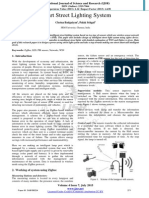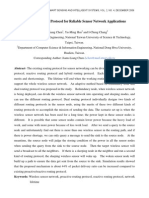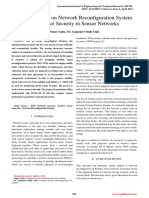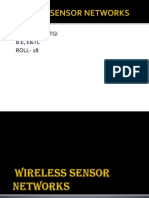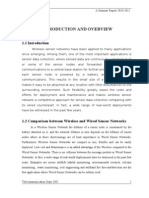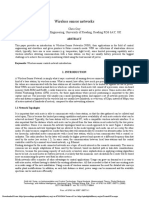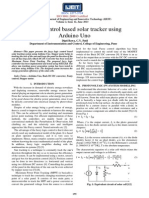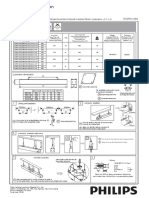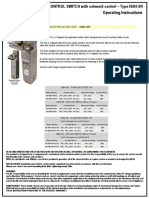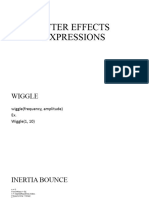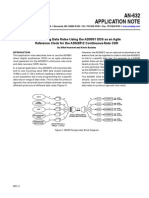Wireless Sensor Network Using Zigbee: Nidhi Patel, Hiren Kathiriya, Arjav Bavarva
Wireless Sensor Network Using Zigbee: Nidhi Patel, Hiren Kathiriya, Arjav Bavarva
Uploaded by
Davidleonardo GalindoCopyright:
Available Formats
Wireless Sensor Network Using Zigbee: Nidhi Patel, Hiren Kathiriya, Arjav Bavarva
Wireless Sensor Network Using Zigbee: Nidhi Patel, Hiren Kathiriya, Arjav Bavarva
Uploaded by
Davidleonardo GalindoOriginal Description:
Original Title
Copyright
Available Formats
Share this document
Did you find this document useful?
Is this content inappropriate?
Copyright:
Available Formats
Wireless Sensor Network Using Zigbee: Nidhi Patel, Hiren Kathiriya, Arjav Bavarva
Wireless Sensor Network Using Zigbee: Nidhi Patel, Hiren Kathiriya, Arjav Bavarva
Uploaded by
Davidleonardo GalindoCopyright:
Available Formats
IJRET: International Journal of Research in Engineering and Technology
ISSN: 2319-1163
WIRELESS SENSOR NETWORK USING ZIGBEE
Nidhi Patel1, Hiren Kathiriya2, Arjav Bavarva3
1, 2, 3
Assistant Professor, EC Department, RK University, Gujarat, India,
nidhi.patel@rku.ac.in, hiren.kathiriya@rku.ac.in, arjav.bavarva@rku.ac.in
Abstract
A wireless sensor network (WSN) consists of sensors which are densely distributed to monitor physical or environmental conditions,
such as temperature, sound, pressure, etc. The sensor data is transmitted to network coordinator which is heart of the wireless
personal area network. In the modern scenario wireless networks contains sensors as well as actuators. ZigBee is newly developed
technology that works on IEEE standard 802.15.4, which can be used in the wireless sensor network (WSN). The low data rates, low
power consumption, low cost are main features of ZigBee. WSN is composed of ZigBee coordinator (network coordinator), ZigBee
router and ZigBee end device. The sensor nodes information in the network will be sent to the coordinator, the coordinator collects
sensor data, stores the data in memory, process the data, and route the data to appropriate node.
Index Terms: WSN, ZigBee.
-----------------------------------------------------------------------***----------------------------------------------------------------------1. INTRODUCTION
Wireless sensor network is a technology for wide range of
wireless environments. Recently more research work has been
done in direction to develop wireless network that works on
low power, low data rate, low cost personal area network.
Many organization has develop WSNs for smart home, smart
farm, smart hospital for patient monitoring, for traffic
monitoring in VANET, fire monitoring in smart cities. The
importance and application has been increased by the recent
delivery of the IEEE 802.15.4 standard and the forthcoming
ZigBee standard. The ZigBee Alliance has developed very
low-cost,
very
low-power
consumption,
wireless
communications standard for network and application layer to
fulfill the demand of automation and remote control
applications. IEEE 802.15.4 committee started working on a
low data rate standard a short while later for physical and
MAC sub layer. Then the ZigBee Alliance and the IEEE
decided to join forces and ZigBee is the commercial name for
this technology.
ZigBee is expected to provide low cost and low power
connectivity for equipment that needs very long battery life as
several months to several years but does not require data
transfer rates as high as those enabled by Bluetooth. Also
ZigBee can be implemented larger networks than is possible
with Bluetooth. ZigBee compliant wireless devices are operate
in the unlicensed RF worldwide (2.4GHz global, 915MHz
Americas or 868 MHz Europe). The data rate is 250kbps at
2.4GHz, 40kbps at 915MHz and 20kbps at 868MHz.
2. WSN
A wireless sensor network is a collection of nodes. Each node
consists of processing capability (one or more MCUs or DSP
chips), multiple types of memory (program, data and flash
memories), a RF transceiver, a power source (batteries), and
accommodates various sensors and actuators [11]. The nodes
communicate wirelessly and often self-organize after being
deployed in an ad hoc fashion. A WSN is a distributed realtime system. Most past distributed systems research has
assumed that the systems are wired, have unlimited power, are
not real time, have a fixed set of resources, treat each node in
the system as very important and are location independent. In
contrast, for wireless sensor networks, the systems are
wireless, have scarce power, are real-time, utilize sensors and
actuators as interfaces, have dynamically changing sets of
resources, aggregate behavior is important and location is
critical. Many wireless sensor networks also utilize minimal
capacity devices which places a further strain on the ability to
use past solutions. Usually these devices are small and
inexpensive, so that they can be produced and deployed in
large numbers, and so their resources in terms of energy,
memory, computational speed and bandwidth are severely
constrained. There are different Sensors such as pressure,
accelerometer, camera, thermal, microphone, etc. They
monitor conditions at different locations, such as temperature,
humidity, vehicular movement, lightning condition, pressure,
soil makeup, noise levels, the presence or absence of certain
kinds of objects, mechanical stress levels on attached objects,
the current characteristics such as speed, direction and size of
an object. Normally these Sensor nodes consist there
components: sensing, processing and communicating.
Wireless Sensor Networks (WSNs) are traditionally composed
of multiple sensor nodes that sense environmental phenomena
and generate sensor readings that are delivered, typically,
through multi-hop paths, to a specific node (called the sink)
for collection [6].
__________________________________________________________________________________________
1038
Volume: 02 Issue: 06 | Jun-2013, Available @ http://www.ijret.org
IJRET: International Journal of Research in Engineering and Technology
ISSN: 2319-1163
multiple sensor nodes are required to overcome environmental
obstacles like obstructions, line of sight constraints etc. The
environment to be monitored has an ad-hoc infrastructure for
communication. Another requirement for sensor networks
would be distributed processing capability because
communication is a major consumer of energy [8].
Fig -1: Traditional Wireless Sensor Network [9]
3. SENSOR AND SENSOR NODE
Sensor is a device that receives and responds to a signal or
stimulus. It is an element that senses a variation in input
energy to produce a variation in another or same form of
energy. A sensor (also called detector) is a converter that
measures a physical quantity and converts it into a signal
which can be read by an observer or by an instrument. For
example thermocouple converts temperature to an output
voltage which can be read by a voltmeter. For accuracy, most
sensors are calibrated against known standards. A sensor is a
device which receives and responds to a signal when touched.
A sensor's sensitivity indicates how much the sensor's output
changes when the measured quantity changes. Sensors that
measure very small changes must have very high sensitivities.
Sensors need to be designed to have a small effect on what is
measured; making the sensor smaller often improves this and
may introduce other advantages. Technological progress
allows more and more sensors to be manufactured on a
microscopic scale as micro sensors using MEMS technology.
In most cases, a micro sensor reaches a significantly higher
speed and sensitivity compared with macroscopic approaches
[10].
The low cost sensors are densely deployed in WSN, which
collect environmental data. The environment can be monitored
and controlled by the use of sensors and actuators in WSN.
Sensor nodes have various energy and computational
constraints because of their inexpensive nature and ad-hoc
method of deployment [8].
Recently research has been developed at energy efficient
routing. The sensor nodes are small and distributed, which are
capable of local processing and wireless communication. Each
sensor node is capable of only a limited amount of processing.
But when coordinated with the information from a large
number of other nodes, they have the ability to measure a
given physical environment in great detail. Thus, a sensor
network can be described as a collection of sensor nodes
which co-ordinate to perform some specific action. Unlike
traditional networks, sensor networks depend on dense
deployment and co-ordination to carry out their tasks. The
Fig.-2: System architecture of a typical wireless sensor node
A sensor node consists of four sub-systems [8]:
3.1 Computing Subsystem
It consists of a microcontroller unit. This controls the sensor
data and executes communication protocols. MCUs are
operated under various operating modes of power
management, for long battery life purpose.
3.2 Communication Subsystem
It consists of a short range radio frequency transceiver, which
is used to communicate with neighboring nodes within cluster
and the outside the cluster. The transceiver can operate under
the Transmit, Receive, Idle and Sleep modes. Power
consumed by the node can be reduced by keeping the node in
sleep mode when it is not transmitting or receiving.
3.3 Sensing Subsystem
This subsystem has wireless sensor nodes and actuators that
form the WSN. In addition it is having a sink node that
connects WSN to internet or another network.
3.4 Power Supply Subsystem
This subsystem consists of battery that supplies power to the
node. A battery should be used at rated current capacity is
lesser than the minimum energy consumption required for
sensor node that leads to the lower battery lifetimes. The
battery lifetime can be increased by reducing the current and
turning node off when not transmitting and receiving. Also the
power consumed by the sensor nodes can be reduced by
applying energy efficient routing algorithm for networks.
__________________________________________________________________________________________
1039
Volume: 02 Issue: 06 | Jun-2013, Available @ http://www.ijret.org
IJRET: International Journal of Research in Engineering and Technology
4. BLOCK DIAGRAM OF WSN
The block diagram of wireless sensor network of the project is
as shown figure below. The ultrasonic proximity sensor is
connected to SPI of a controller 89v51 through buffer
IC74LS125. The ZigBee module-1 (Tarang F4) is also
connected to SPI via buffer. They are communicating
alternatively via buffer IC. The temperature sensor LM35 is
connected to port-1 via ADC-0804. The LCD is connected to
port-2 of MCU. ZigBee module-1 is communicating to ZigBee
module-2 (Tarang F4) via wireless radio link. The ZigBee
module-2 is connected to PC via RS-232 cable. The sensing
data is displayed on the LCD then to PC Hyper-terminal.
The ultrasonic proximity sensor is used to measure the
distance of any stationary object. The sensor data is captured
at serial port of an MCU. This data is stored in MCU memory
as well as displayed on LCD. The sensor can measure distance
minimum 10cm and maximum 400cm (4m). If distance is less
then 10cm the message is displayed on LCD that distance is
lesser then min range. The data pin of ultrasonic proximity
sensor is connected to RXD pin of MCU through buffer. The
data received on RXD pin by the MCU is in ASCII format at
data rate of 9600 baud rate. The received data format is
XXX.XXcm<CR>, where X is 0 to 9 ASCII character and
<CR> is carriage return where the string terminates.
The temperature sensor LM-35 is used to sense the
environmental temperature. The Vout pin of LM-35 is
connected to Vin pin of ADC for analog to digital
conversation. The 8 bit digital output DB0 to DB7 is
connected to port1 of MCU. The temperature reading of 8 bit
stored inside MCU memory. The LM35 is precision
integrated-circuit temperature sensor, whose output voltage is
linearly proportional to the Celsius (Centigrade) temperature.
This will require a voltmeter to sense the temperature. Vout
can be measured by voltmeter. The output voltage is converted
to temperature by a simple conversion factor. The sensor has a
sensitivity of 10mV/
. Hence conversion factor is the
reciprocal, and that is 100 /V. The general equation used to
convert output voltage to temperature is:
So if Vout is 1V, then, Temperature = 100 . The output
voltage varies linearly with temperature. Temperature reading
is also displayed on LCD with the distance reading.
ZigBee module1 is connected to MCU via SPI. The Dout pin
of ZigBee module is connected to RXD pin of MCU via buffer
IC and Din pin of ZigBee module is connected to TXD pin of
MCU. Both the sensor data can be transfer to Zigbee module1
through wired connection. This sensor data is transferred to
ZigBee module to via radio link. ZigBee module2 is
ISSN: 2319-1163
connected to COM port of PC via RS232 cable. The same
sensors reading displayed on the LCD can be displayed on PC
in hyper terminal. Here the network formed by both the
ZigBee module is unicast network, communication between
two nodes only. For unicast network it needs to assign source
address and destination address for both of the ZigBee
module. The Zigbee module used in this project is Tarang-F4
module, which works on 3.3v to 3.6v operating voltage and
ISM 2.4 GHz band of frequency.
Fig- 3: Block diagram of wireless sensor network
5. ZIGBEE/IEEE STANDARD 802.15.4
ZigBee is a worldwide open standard for wireless radio
networks in the monitoring and control fields. The standard
was developed by the ZigBee Alliance (an association of
international companies) to meet the following principal
needs:
Low cost
Ultra-low power consumption
Use of unlicensed radio bands
Cheap and easy installation
Flexible and extendable networks
Integrated intelligence for network set-up and
message routing
Some of the above requirements are related - for example, the
need for extremely low power consumption is motivated by
the use of battery-powered nodes which can be installed
cheaply and easily, without any power cabling, in difficult
locations.
The IEEE 802.15.4 standard defines the characteristics of the
physical and MAC layers for Low-Rate Wireless Personal
Area Networks (LR-WPAN). The figure shows a generic LRWPAN node architecture. The node architecture is defined
into a number of structural blocks called layers. Each layer
implements a subset of the LR-WPAN standard and offers
services to its upper layers and gets services from its lower
layers. The layered architecture of each network node
__________________________________________________________________________________________
1040
Volume: 02 Issue: 06 | Jun-2013, Available @ http://www.ijret.org
IJRET: International Journal of Research in Engineering and Technology
comprises Physical (PHY) layer and Medium Access Control
(MAC) sublayer. On top of these layers is the Service Specific
Convergence Sublayer (SSCS) which interfaces the MAC
sublayer to the logical link control sublayer and other upper
layers such as the networking layer which provides network
configuration, manipulation and message routing,and
application layer, which provides intended function of device.
The LR-WPANs standards are defined only for the physical
layer and medium access control sublayer while other layers
specifications are undefined in the standards [1].
ISSN: 2319-1163
kbit/s). The protocol also allows dynamic channel selection, a
channel scan function in search of a beacon, receiver energy
detection, link quality indication and channel switching. All of
these frequency bands are based on the Direct Sequence
Spread Spectrum (DSSS) spreading technique. The 2450 MHz
band employs Offset Quadrature Phase Shift Keying (OQPSK) for modulation while the 868/915 MHz bands rely on
Binary Phase Shift Keying (BPSK) [2].
Fig. -5: Frequency band and channel assignment
Fig. -4: Node architecture of LR-WPAN device [1, 7]
The physical layer provides two services: the PHY data
service and PHY management service interfacing to the
Physical Layer Management Entity (PLME). The PHY data
service enables the transmission and reception of PHY
Protocol Data Units (PPDU) across the physical radio channel.
The physical layer of IEEE 802.15.4 is in charge of the
following tasks [5]:
Activation and deactivation of the radio transceiver
Energy Detection (ED)
Link Quality Indication (LQI)
Clear Channel Assessment (CCA)
Channel Frequency Selection
The MAC sub layer provides two services: the MAC data
service and the MAC management service interfacing to the
MAC sub layer Management Entity (MLME) Service Access
Point (SAP) (MLME-SAP). The MAC data service enables
the transmission and reception of MAC Protocol Data Units
(MPDU) across the PHY data service. The features of MAC
sub layer are beacon management, channel access control
through the Carrier Sense Multiple Access with Collision
Avoidance (CSMA/CA) scheme, collision-free time slots
management, frame validation, acknowledged frame delivery
and node association and disassociation [1]
6. ZIGBEE NETWORK TOPOLOGIES
The message is routed from one network node to another
depends on the network topology. A ZigBee network can
adopt one of the three topologies: Star, Tree, and Mesh.
6.1 Star Topology
A Star network has a central node, which is linked to all other
nodes in the network. All messages travel via the central node.
The IEEE 802.15.4 offers three operational frequency bands:
2.4 GHz (worldwide), 915(North America) MHz and
868(Europe) MHz. There is a single channel between 868 and
868.6 MHz (20 kbit/s) 10 channels between 902 and 928 MHz
(40 kbit/s), and 16 channels between 2.4 and 2.4835 GHz (250
__________________________________________________________________________________________
1041
Volume: 02 Issue: 06 | Jun-2013, Available @ http://www.ijret.org
IJRET: International Journal of Research in Engineering and Technology
ISSN: 2319-1163
CONCLUSIONS
A Wireless sensor network is flexible in nature and has very
good features like fault tolerance, High sensing fidelity, low
cost etc. which can be very useful to develop exciting
applications for remote sensing but the realization of sensor
networks needs to satisfy the constraints introduced by factors
such as fault tolerance, scalability, cost, hardware, topology
change, environment and power consumption. As we know
these constraints are highly stringent and specific for sensor
networks, some new wireless ad hoc networking techniques
are required.
Fig. -6: Star topology [4]
6.2 Tree Topology
A Tree network has a top node with a branch/leaf structure
below. To reach its destination, a message travels up the tree
(as far as necessary) and then down the tree.
Fig. -7: Tree topology [4]
6.3 Mesh Topology
A Mesh network has a tree-like structure in which some leaves
are directly linked. Messages can travel across the tree, when a
suitable route is available.
REFERENCES
[1]. Hussein T. Mouftah Khaled A. Ali, "Wireless personal
area networks architecture and protocols for multimedia
applications," Ad Hoc Networks, vol. 9, pp. 675686, 2011.
[2]. Prashant Pillai, Vince W.C. Chook, Stefano Chessa,
Alberto Gotta,Y. Fun Hu Paolo Baronti, "Wireless sensor
networks: A survey on the state of the art and the 802.15.4 and
ZigBee standards," Computer Communications, vol. 30, pp.
16551695, 2007.
[3]. ZigBee Alliance, ZigBee Specification, January.2008,
ZigBee Document 053474r17.
[4] http://www.jennic.com/elearning/zigbee/files/html/module
1/ module1-3.htm.
[5]. Ricardo Augusto Rodrigues da Silva Severino, "On the
use of IEEE 802.15.4/ZigBee for Time-Sensitive Wireless
Sensor Network Applications," Polytechnic Institute of Porto,
2008.
[6]. F. Cuomo et al., Cross-layer network formation for
energy-efficient IEEE 802.15.4/ZigBee Wireless Sensor
Networks, Ad Hoc Netw. (2011).
[7]. Standard for part 15.4: Wireless MAC and PHY
specifications for low rate WPAN, IEEE Std 802.15.4, IEEE,
New York, NY (Oct 2003).
[8]. Vijay Anand Sai Ponduru Archana Bharathidasan,
"Sensor Networks: An Overview," Department of Computer
Science, University of California, Davis, CA 95616,.
[9]. http://monet.postech.ac.kr/research.html.
[10]. http://en.wikipedia.org/wiki/Sensor.
[11]. John A. Stankovic, "Wireless Sensor Networks,"
University of Virginia, Charlottesville, Virginia, 2006.
[12]. M. Martal, G. Ferrari P. Medagliani, "Clustered Zigbee
networks with data fusion: Characterization," Ad Hoc
Networks, vol. 9, pp. 10831103, 2011.
[13]. Ioannis Tsetsinas, Eirini Karapistoli,Fotini-Niovi
Pavlidou Ioannis Gragopoulos, "FP-MAC: A distributed MAC
algorithm for 802.15.4-like wireless sensor networks," Ad Hoc
Networks, vol. 6, pp. 953969, 2008.
[14]. Jonas Olsson Johan Lnn, "ZigBee for wireless
networking," Linkping University, Master Thesis work 2005.
[15]. F. L. LEWIS, "Wireless Sensor Networks," The
University of Texas, Arlington, research report.
Fig. -8: Mesh topology [4]
__________________________________________________________________________________________
1042
Volume: 02 Issue: 06 | Jun-2013, Available @ http://www.ijret.org
You might also like
- CEC365 Wireless Sensor Network DesignDocument40 pagesCEC365 Wireless Sensor Network DesignParanthaman G100% (2)
- Smart Street Lighting SystemDocument4 pagesSmart Street Lighting SystemVeronica George0% (2)
- XiR-P8600i Datasheets PDFDocument4 pagesXiR-P8600i Datasheets PDFBao Quoc MaiNo ratings yet
- Ladder Logic Example For Beginners - Over Head Water Tank Automatic Level ControlDocument3 pagesLadder Logic Example For Beginners - Over Head Water Tank Automatic Level ControlDerbel Walid100% (1)
- A Review: Wireless Sensor Networks and Its Application, Platforms, Standards and ToolsDocument7 pagesA Review: Wireless Sensor Networks and Its Application, Platforms, Standards and ToolsseventhsensegroupNo ratings yet
- Yellampalli S. Wireless Sensor Networks - Design, Deployment..2021Document314 pagesYellampalli S. Wireless Sensor Networks - Design, Deployment..2021Myster SceneNo ratings yet
- Wireless Sensor NetworksDocument7 pagesWireless Sensor NetworksminakshiNo ratings yet
- WSN-1Document13 pagesWSN-1sidideapadNo ratings yet
- 1.1. Wireless Sensor NetworksDocument19 pages1.1. Wireless Sensor NetworksTechnos_IncNo ratings yet
- Energy Conservation Challenges in Wireless SensorDocument9 pagesEnergy Conservation Challenges in Wireless SensorAnveshkumar NellaNo ratings yet
- Ant Colony Optimization For Improving Network Lifetime in Wireless Sensor NetworksDocument7 pagesAnt Colony Optimization For Improving Network Lifetime in Wireless Sensor NetworksInternational Journal of Application or Innovation in Engineering & ManagementNo ratings yet
- Ijtra 140911Document3 pagesIjtra 140911International Jpurnal Of Technical Research And ApplicationsNo ratings yet
- Wireless Sensor Networks - CambriaDocument3 pagesWireless Sensor Networks - CambriaNaveen P KalroNo ratings yet
- Adaptive Routing Protocol For Reliable Sensor Network ApplicationsDocument25 pagesAdaptive Routing Protocol For Reliable Sensor Network ApplicationsLehel TothNo ratings yet
- Compusoft, 3 (4), 746-751 PDFDocument6 pagesCompusoft, 3 (4), 746-751 PDFIjact EditorNo ratings yet
- ReportDocument26 pagesReportDeepak_Gilkarw_7497No ratings yet
- Context Monitoring of A Patient Using Wireless Networks: AbstractDocument10 pagesContext Monitoring of A Patient Using Wireless Networks: Abstractsatish kumarNo ratings yet
- Ijct,+Journal+Editor,+1 Harpinder PaperDocument7 pagesIjct,+Journal+Editor,+1 Harpinder PaperViraj KaleNo ratings yet
- Wireless Sensor Networks Unit I Characteristic Requirements For WsnsDocument47 pagesWireless Sensor Networks Unit I Characteristic Requirements For WsnssulakchanaNo ratings yet
- EAR ClusterDocument20 pagesEAR ClusterNivedita Acharyya 2035No ratings yet
- Developing An Energy Conserving Routing Application For A Sensor Node in Wireless Sensor Network by Utilizing The Wiselib Algorithm LibraryDocument8 pagesDeveloping An Energy Conserving Routing Application For A Sensor Node in Wireless Sensor Network by Utilizing The Wiselib Algorithm Libraryaayush_shrutNo ratings yet
- Energy Consumption in Wireless Sensor NetworkDocument5 pagesEnergy Consumption in Wireless Sensor Networkram prakashNo ratings yet
- A Survey On Wireless Sensor Network ArchDocument4 pagesA Survey On Wireless Sensor Network ArchNYOBENo ratings yet
- BWSNDocument10 pagesBWSNsoumyaranjan4104No ratings yet
- Ijetr022726 PDFDocument5 pagesIjetr022726 PDFerpublicationNo ratings yet
- Wireless Sensor Networks - IntroductionDocument21 pagesWireless Sensor Networks - IntroductionBalamurugan GopalakrishnanNo ratings yet
- WSN Unit 1Document22 pagesWSN Unit 1Gaurav bansodeNo ratings yet
- WSN Ut1Document21 pagesWSN Ut1Asim SiddiquiNo ratings yet
- Reliable Energy Efficient Clustering Scheme Analysis Using Mobile Sink in Wireless Sensor NetworksDocument6 pagesReliable Energy Efficient Clustering Scheme Analysis Using Mobile Sink in Wireless Sensor NetworksseventhsensegroupNo ratings yet
- IOT Based Fire Detection System - Formatted PaperDocument7 pagesIOT Based Fire Detection System - Formatted PaperURK19CS1070 KEYURI YALLANo ratings yet
- Ch-2 Hardware For IoTDocument37 pagesCh-2 Hardware For IoTPatil MangeshNo ratings yet
- Iwsn Unit 2Document18 pagesIwsn Unit 2Siddharth SainiNo ratings yet
- Matrix Based Energy Efficient Routing in Static Wireless Sensor NetworksDocument9 pagesMatrix Based Energy Efficient Routing in Static Wireless Sensor NetworksInternational Journal of Sensor & Related NetworksNo ratings yet
- IJETR032017Document5 pagesIJETR032017erpublicationNo ratings yet
- Mohit Rohatgi B.E, E&TC ROLL-28Document17 pagesMohit Rohatgi B.E, E&TC ROLL-28shanktc2011No ratings yet
- Unit 2Document23 pagesUnit 2mukul.money2003No ratings yet
- MOTES - Low Power Wireless Sensor NetworkDocument26 pagesMOTES - Low Power Wireless Sensor NetworkVinay MohanNo ratings yet
- Wireless Sensor Networks: Security, Attacks and ChallengesDocument13 pagesWireless Sensor Networks: Security, Attacks and ChallengesPradip KumarNo ratings yet
- Wireless Sensor Networks - Future of Wireless ApplicationsDocument11 pagesWireless Sensor Networks - Future of Wireless ApplicationssingaraNo ratings yet
- 1.1 Introduction To Project: in The Recent Years, As The Development of Wireless Sensor Networks People HasDocument32 pages1.1 Introduction To Project: in The Recent Years, As The Development of Wireless Sensor Networks People HasGopi Nath SNo ratings yet
- Full Seminar ReportDocument17 pagesFull Seminar Reportnaveenb273No ratings yet
- Final Report Wireless Sensor NettworkDocument44 pagesFinal Report Wireless Sensor NettworkRupam VaghasiyaNo ratings yet
- Virtual Energy Based Encryption & Keying On Wireless Sensor NetworkDocument10 pagesVirtual Energy Based Encryption & Keying On Wireless Sensor NetworkInternational Organization of Scientific Research (IOSR)No ratings yet
- تحديات ال wsns PDFDocument5 pagesتحديات ال wsns PDFfree5050No ratings yet
- Addis Abeba Science and Technology University: College of Mechanical and Electrical EngineeringDocument28 pagesAddis Abeba Science and Technology University: College of Mechanical and Electrical EngineeringAndyNo ratings yet
- Project Report On Super Nodes - An Embedded ApproachDocument24 pagesProject Report On Super Nodes - An Embedded ApproachKarthikNo ratings yet
- Seminar ReportDocument26 pagesSeminar Reportharishk03No ratings yet
- Wireless Sensor Networks: Chris Guy School of Systems Engineering, University of Reading, Reading RG6 6AY, UKDocument4 pagesWireless Sensor Networks: Chris Guy School of Systems Engineering, University of Reading, Reading RG6 6AY, UKMedNo ratings yet
- Bluetooth Based Wireless Sensor Networks - Implementation Issues and SolutionsDocument7 pagesBluetooth Based Wireless Sensor Networks - Implementation Issues and SolutionsSai Divya GoudNo ratings yet
- Wireless Sensor NetworkDocument3 pagesWireless Sensor NetworkShounak KatyayanNo ratings yet
- Wireless Sensor NetworksDocument10 pagesWireless Sensor NetworksAhmet TuncaNo ratings yet
- Wireless Sensor NetworksDocument37 pagesWireless Sensor NetworksHemant MahajanNo ratings yet
- Data-Centric Routing Protocols in Wireless Sensor Networks: A SurveyDocument6 pagesData-Centric Routing Protocols in Wireless Sensor Networks: A SurveyAnuskaNo ratings yet
- Unit 1 Class:II-M.Sc., (CS) Two MarksDocument19 pagesUnit 1 Class:II-M.Sc., (CS) Two MarksRevathy G0% (1)
- WSNDocument12 pagesWSNzeemadevaksathaNo ratings yet
- Wireless Sensor NetworksDocument9 pagesWireless Sensor Networkskrishcoolcalm5880No ratings yet
- Thesis On Wireless Sensor Network Routing ProtocolDocument87 pagesThesis On Wireless Sensor Network Routing ProtocolNancyNo ratings yet
- Unit 1 WSN.Document37 pagesUnit 1 WSN.Yash GargNo ratings yet
- Energy Efficient Direction-Based Topology Control Algorithm For WSNDocument11 pagesEnergy Efficient Direction-Based Topology Control Algorithm For WSNambie tubeNo ratings yet
- Unit III WN Notes - 1708339758Document11 pagesUnit III WN Notes - 1708339758Mine InstrumentsNo ratings yet
- Handbook of Ultra-Wideband Short-Range Sensing: Theory, Sensors, ApplicationsFrom EverandHandbook of Ultra-Wideband Short-Range Sensing: Theory, Sensors, ApplicationsNo ratings yet
- SECC - Design and Implementation of ZigBee Based Infrastructure For Smart EnvironmentsDocument26 pagesSECC - Design and Implementation of ZigBee Based Infrastructure For Smart EnvironmentsDavidleonardo GalindoNo ratings yet
- WWW - Unlock PDF - Com 952928Document23 pagesWWW - Unlock PDF - Com 952928Davidleonardo GalindoNo ratings yet
- Fuzzy Controller Design Using FPGA For Sun Tracking in Solar Array SystemDocument7 pagesFuzzy Controller Design Using FPGA For Sun Tracking in Solar Array SystemDavidleonardo GalindoNo ratings yet
- Embedded System Based On A Real Time Fuzzy Motor Speed ControllerDocument11 pagesEmbedded System Based On A Real Time Fuzzy Motor Speed ControllerDavidleonardo GalindoNo ratings yet
- Fuzzy Control Based Solar Tracker Using Arduino Uno: ISO 9001:2008 CertifiedDocument9 pagesFuzzy Control Based Solar Tracker Using Arduino Uno: ISO 9001:2008 CertifiedDavidleonardo GalindoNo ratings yet
- Episode 06 Parts ListDocument1 pageEpisode 06 Parts ListDavidleonardo GalindoNo ratings yet
- LabVIEW - Connect To MySQLDocument6 pagesLabVIEW - Connect To MySQLDavidleonardo GalindoNo ratings yet
- 3 Andren IEC61499 4DIAC Lab AutomationDocument21 pages3 Andren IEC61499 4DIAC Lab AutomationDavidleonardo GalindoNo ratings yet
- System Identification and Estimation in LabVIEWDocument99 pagesSystem Identification and Estimation in LabVIEWDavidleonardo GalindoNo ratings yet
- Do Cum en ToDocument1 pageDo Cum en ToDavidleonardo GalindoNo ratings yet
- SRAN13.1 CloudAIR Feature Description (Digicel)Document44 pagesSRAN13.1 CloudAIR Feature Description (Digicel)Luis Carlos SilvaNo ratings yet
- FH 052 070 EAV1 Service Manual PDFDocument128 pagesFH 052 070 EAV1 Service Manual PDFGustavo Mosquera0% (1)
- DRV 8844Document28 pagesDRV 8844Amine Hadj SayahNo ratings yet
- B2C Lighting - Product Explorer 2018-Vol IDocument40 pagesB2C Lighting - Product Explorer 2018-Vol IAshish Tamang0% (1)
- AntennaDocument129 pagesAntennaChonny Reyes E100% (2)
- L Series: ApplicationsDocument2 pagesL Series: Applicationsjonathan cruzNo ratings yet
- Bipolar TransistorDocument8 pagesBipolar Transistorfcmandi100% (1)
- Smartbright Suspension Rc095VDocument2 pagesSmartbright Suspension Rc095VDewa AgungNo ratings yet
- Protection of Transmission Line Using GPSDocument11 pagesProtection of Transmission Line Using GPSRajeswari Vayugundla100% (6)
- Anti Rolling Gyro Arg175tDocument62 pagesAnti Rolling Gyro Arg175tmaxNo ratings yet
- Gardena Robotic Lawnmower Gardena Robotic Lawnmower: Installation Manual Installation ManualDocument88 pagesGardena Robotic Lawnmower Gardena Robotic Lawnmower: Installation Manual Installation ManualZyXEL GiedriusNo ratings yet
- Trapped Key CONTROL SWITCH With Solenoid Control - Type ISB4-SRDocument2 pagesTrapped Key CONTROL SWITCH With Solenoid Control - Type ISB4-SRAlex GarduñoNo ratings yet
- Section 4 2 Impedance and Admittance Matricies PackageDocument25 pagesSection 4 2 Impedance and Admittance Matricies PackageMohammed AlhakeemiNo ratings yet
- B5 An IoT Based Smart E-Fuel Stations Using ESP-32Document32 pagesB5 An IoT Based Smart E-Fuel Stations Using ESP-32kalemula sahithiNo ratings yet
- Surtron 400 TouchDocument9 pagesSurtron 400 TouchHeidi BlueNo ratings yet
- Dynamic Logic CktsDocument16 pagesDynamic Logic CktsaashishscribdNo ratings yet
- MITSUBISHDocument17 pagesMITSUBISHEder AlexandreNo ratings yet
- Vlsi System DesignDocument12 pagesVlsi System DesignNaresh BandariNo ratings yet
- pk40 GBDocument1 pagepk40 GBAgustin EstergaardNo ratings yet
- SN65176 Texas RS422Document18 pagesSN65176 Texas RS422Alex SantosNo ratings yet
- IJSEA05081002Document4 pagesIJSEA05081002Masudur RahmanNo ratings yet
- After Effects ExpressionsDocument9 pagesAfter Effects Expressionscris18.magoNo ratings yet
- Las Science5 Melc 2 q3 Week-2Document8 pagesLas Science5 Melc 2 q3 Week-2Rycel Mae dela TorreNo ratings yet
- Homelite 18V Hedge Trimmer - UT31840 - Users ManualDocument18 pagesHomelite 18V Hedge Trimmer - UT31840 - Users ManualgunterivNo ratings yet
- AD9951 AppnoteDocument6 pagesAD9951 Appnoteshabaz_yousaf2734No ratings yet
- Digital QRP SWR/ Power Meter 1Document12 pagesDigital QRP SWR/ Power Meter 1Siapo AjoNo ratings yet
- X4 60kW CCS2 DualGun Tech SpecsDocument3 pagesX4 60kW CCS2 DualGun Tech SpecsAdarsh BhuskatNo ratings yet
- 50 Top Transistor Biasing Questions and Answers PDFDocument7 pages50 Top Transistor Biasing Questions and Answers PDFarijitlgsp0% (1)

